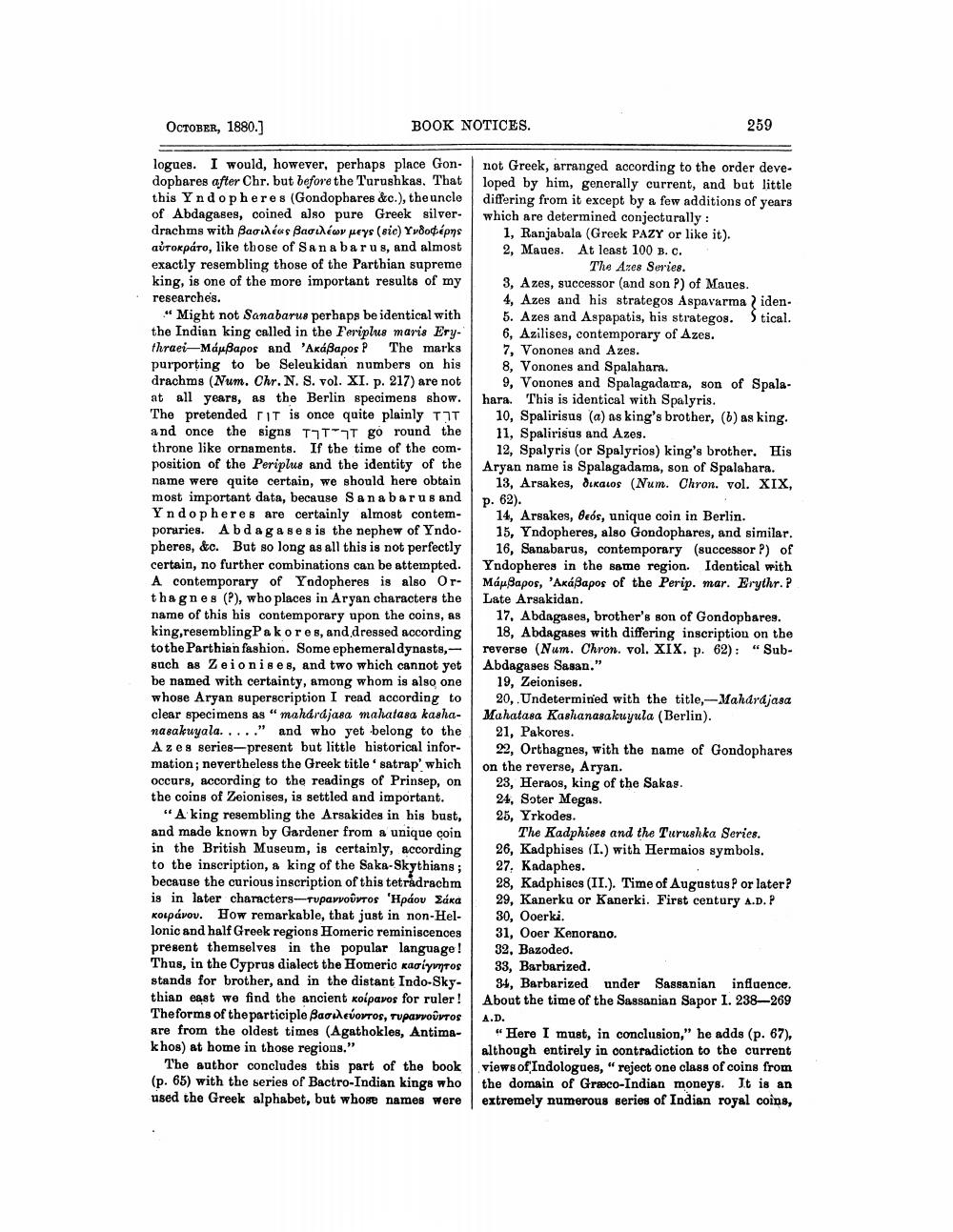________________
BOOK NOTICES.
OCTOBER, 1880.]
logues. I would, however, perhaps place Gondophares after Chr. but before the Turushkas. That this Yndopheres (Gondophares &c.), the uncle of Abdagases, coined also pure Greek silverdrachms with βασιλέως βασιλέων μεγς (sic) Υνδοφέρης AUTOKρáTO, like those of Sana barus, and almost exactly resembling those of the Parthian supreme king, is one of the more important results of my researches.
"Might not Sanabarus perhaps be identical with the Indian king called in the Feriplus maris Erythraei-Μάμβαρος and ’Ακάβαρος P The marks purporting to be Seleukidan numbers on his drachms (Num. Chr. N. S. vol. XI. p. 217) are not at all years, as the Berlin specimens show. The pretended гIT is once quite plainly TT and once the signs TTT go round the throne like ornaments. If the time of the composition of the Periplus and the identity of the name were quite certain, we should here obtain most important data, because Sanabarus and Yndopheres are certainly almost contemporaries. Abdagases is the nephew of Yndopheres, &c. But so long as all this is not perfectly certain, no further combinations can be attempted. A contemporary of Yndopheres is also Orthagnes (P), who places in Aryan characters the name of this his contemporary upon the coins, as king, resembling Pakores, and dressed according to the Parthian fashion. Some ephemeral dynasts,such as Zeionises, and two which cannot yet be named with certainty, among whom is also one whose Aryan superscription I read according to clear specimens as "mahárájasa mahatasa kashanasakuyala....." and who yet belong to the Azes series-present but little historical information; nevertheless the Greek title' satrap' which occurs, according to the readings of Prinsep, on the coins of Zeionises, is settled and important.
"A king resembling the Arsakides in his bust, and made known by Gardener from a unique coin in the British Museum, is certainly, according to the inscription, a king of the Saka-Skythians; because the curious inscription of this tetradrachm is in later characters--τυραννοῦντος Ηράου Σάκα KOLрávov. How remarkable, that just in non-Hellonic and half Greek regions Homeric reminiscences present themselves in the popular language! Thus, in the Cyprus dialect the Homeric kariyηroS stands for brother, and in the distant Indo-Skythian east we find the ancient koipavos for ruler! The forme of the participle βασιλεύοντος, τυραννοῦντος are from the oldest times (Agathokles, Antimakhos) at home in those regions."
The author concludes this part of the book (p. 65) with the series of Bactro-Indian kings who used the Greek alphabet, but whose names were
not Greek, arranged according to the order developed by him, generally current, and but little differing from it except by a few additions of years which are determined conjecturally:
1, Ranjabala (Greek PAZY or like it). 2, Maues. At least 100 B. c. The Azes Series.
259
3, Azes, successor (and son ?) of Maues. 4, Azes and his strategos Aspavarma iden. 5. Azes and Aspapatis, his strategos.
tical.
6, Azilises, contemporary of Azes. 7, Vonones and Azes.
8, Vonones and Spalahara.
9, Vonones and Spalagadama, son of Spalahara. This is identical with Spalyris.
10, Spalirisus (a) as king's brother, (b) as king. 11, Spalirisus and Azes.
12, Spalyris (or Spalyrios) king's brother. His Aryan name is Spalagadama, son of Spalahara.
13, Arsakes, dikaios (Num. Chron. vol. XIX, p. 62).
14, Arsakes, Beós, unique coin in Berlin. 15, Yndopheres, also Gondophares, and similar. 16, Sanabarus, contemporary (successor ?) of Yndopheres in the same region. Identical with Máußapos, 'Akáẞapos of the Perip. mar. Erythr.? Late Arsakidan.
17. Abdagases, brother's son of Gondophares. 18, Abdagases with differing inscription on the reverse (Num. Chron. vol. XIX. p. 62): "SubAbdagases Sasan."
19, Zeionises.
20, Undetermined with the title,-Maharajasa Mahatasa Kashanasakuyula (Berlin).
21, Pakores.
22, Orthagnes, with the name of Gondophares on the reverse, Aryan.
23, Heraos, king of the Sakas.
24, Soter Megas.
25, Yrkodes.
The Kadphises and the Turushka Series. 26, Kadphises (I.) with Hermaios symbols. 27. Kadaphes.
28, Kadphises (II.). Time of Augustus ? or later? 29, Kanerku or Kanerki. First century A.D. P 30, Ooerki.
31, Ooer Kenorano.
32, Bazodeo.
33, Barbarized.
34, Barbarized under Sassanian influence. About the time of the Sassanian Sapor I. 238-269
A.D.
"Here I must, in conclusion," he adds (p. 67), although entirely in contradiction to the current views of Indologues, " reject one class of coins from the domain of Græco-Indian moneys. It is an extremely numerous series of Indian royal coins,




